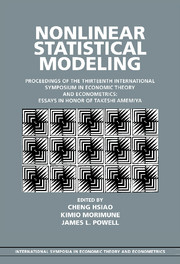 Nonlinear Statistical Modeling
Nonlinear Statistical Modeling Book contents
- Frontmatter
- Contents
- Series editor's introduction
- Editors' introduction
- Contributors
- 1 Local instrumental variables
- 2 Empirically relevant power comparisons for limited-dependent-variable models
- 3 Simulation estimation of polychotomous-choice sample selection models
- 4 A new approach to the attrition problem in longitudinal studies
- 5 Semiparametric estimation for left-censored duration models
- 6 Semiparametric estimation of censored selection models
- 7 Studentization in Edgeworth expansions for estimates of semiparametric index models
- 8 Nonparametric identification under response-based sampling
- 9 On selecting regression variables to maximize their significance
- 10 Using information on the moments of disturbances to increase the efficiency of estimation
- 11 Minimal conditions for weak convergence of the sample standardized spectral distribution function
- 12 Unit root tests for time series with a structural break when the break point is known
- 13 Power comparisons of the discontinuous trend unit root tests
- 14 On the simultaneous switching autoregressive model
- 15 Some econometrics of scarring
- 16 A censored switching regression approach to evaluating the effect of sunk costs and firm-level disequilibrium on export performance
- Curriculum vitae of Takeshi Amemiya
- Index
10 - Using information on the moments of disturbances to increase the efficiency of estimation
Published online by Cambridge University Press: 05 June 2012
- Frontmatter
- Contents
- Series editor's introduction
- Editors' introduction
- Contributors
- 1 Local instrumental variables
- 2 Empirically relevant power comparisons for limited-dependent-variable models
- 3 Simulation estimation of polychotomous-choice sample selection models
- 4 A new approach to the attrition problem in longitudinal studies
- 5 Semiparametric estimation for left-censored duration models
- 6 Semiparametric estimation of censored selection models
- 7 Studentization in Edgeworth expansions for estimates of semiparametric index models
- 8 Nonparametric identification under response-based sampling
- 9 On selecting regression variables to maximize their significance
- 10 Using information on the moments of disturbances to increase the efficiency of estimation
- 11 Minimal conditions for weak convergence of the sample standardized spectral distribution function
- 12 Unit root tests for time series with a structural break when the break point is known
- 13 Power comparisons of the discontinuous trend unit root tests
- 14 On the simultaneous switching autoregressive model
- 15 Some econometrics of scarring
- 16 A censored switching regression approach to evaluating the effect of sunk costs and firm-level disequilibrium on export performance
- Curriculum vitae of Takeshi Amemiya
- Index
Summary
Foreword
This chapter was originally written in 1981, with a draft distributed as a National Bureau of Economic Research Working paper (No. 2, May 1982). Although this study was never publicly disseminated in another form, several articles published in the 1980s and 1990s cited and built upon its findings. No paper of mine better reflects just how much Takeshi has influenced my education and research. It is a sentimental favorite of mine for this reason and, thus, is an especially fitting offering for my contribution to Takeshi's Festschrift. The chapter that follows – a modest revision of the NBER Working paper completed in June 1982 – is the version I have sent upon receiving requests for the paper. To preserve its authenticity, the following text incorporates nothing more than editorial changes.
Subsequent work has, of course, expanded and refined many of the results presented in this 1982 paper. The Afterword at the end of this chapter summarizes these developments, attempting to place the 1982 findings presented here into the context of the current literature.
Finally, an appendix follows the Afterword summarizing the results of a small Monte Carlo analysis that investigates the practical applicability of the estimation approach proposed in this chapter. The absence of such evidence made the results of the original work of theoretical interest, but of little functional use. Contrary to many researchers' suspicions, these Monte Carlo findings suggest that substantial efficiency gains may be attainable by implementing these estimation procedures.
- Type
- Chapter
- Information
- Nonlinear Statistical ModelingProceedings of the Thirteenth International Symposium in Economic Theory and Econometrics: Essays in Honor of Takeshi Amemiya, pp. 281 - 320Publisher: Cambridge University PressPrint publication year: 2001
- 1
- Cited by


